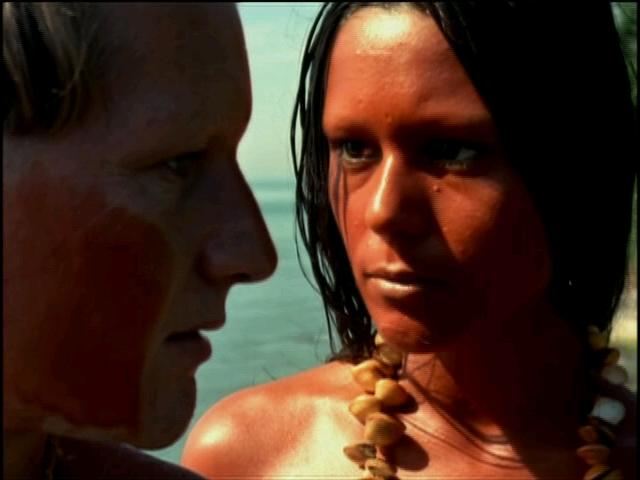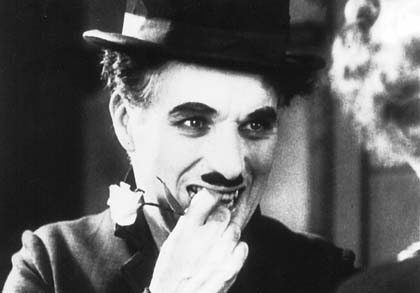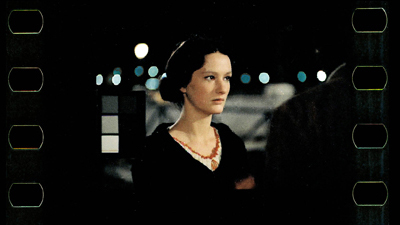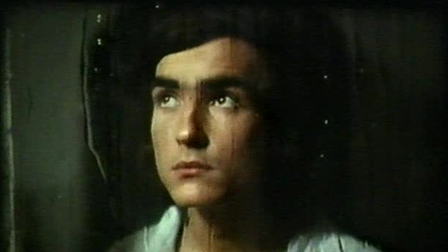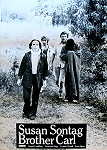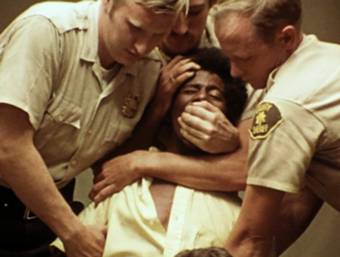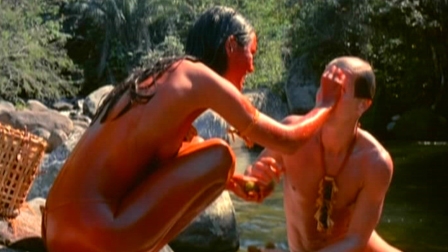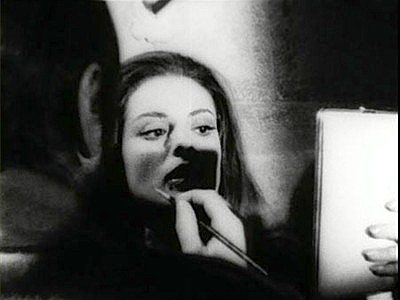This page of festival coverage in The Village Voice (June 17, 1971) appeared (without any photos) after my second trip to the festival; if memory serves, my first trip there, in 1970, yielded no writing at all. One complication about this piece is that Amos Vogel and I jointly discovered after arriving at the festival that a separate editor at the Voice had given each of us the assignment of “covering” the festival. After Amos checked back at the front office about this, it was agreed at the Voice that we both write coverage, about separate films, which we wound up doing for two years in a row.
I think this article manages to convey some of the political flavor of the early 70s, although it’s worth adding that all the films listed here with the exception of Sontag’s Brother Carl are currently either available on DVD [2023 update: Sontag’s film is now available on a Swedish DVD.] or are about to be (e.g., Portabella’s Cuadecuc – Vampir, identified here incorrectly as Vampyr). Indeed, strange as it seems, the most “out of date” detail here is a single shot I describe in Cuadecuc – Vampir (“a ghoulishly made-up actress making a face at someone between takes”), which Portabella inexplicably (and lamentably) has subsequently removed from the film. –-J.R.
Moviegoing at Cannes: Classics without labels
By Jonathan Rosenbaum
CANNES, France – With its continual efforts to impress and entertain, the Cannes Film Festival usually guaranteed at least one genuine pseudo-event every 45 minutes, and after two weeks of this congenial bribery, it is hard to feel much sense of deprivation. In addition to the 30 features I saw and the 20 more I sampled, the mood of on-going spectacle was so constant that one eventually began to cherish unphotogenic faces and objects as though they were precious secrets.
In a climate of such calculated hardsell, one can hardly twitch a muscle without inadvertently becoming part of someone else’s publicity campaign. Last year, while Warner Brothers was throwing a cocktail party to promote Woodstock, the director, Michael Wadleigh, was dedicating the film to the students killed at Kent State and passing out black armbands. I wore one of the armbands for a while, until I realized that by doing so I was helping to do Warner Brothers’ work; later, I’m told, the armbands became so popular in Cannes that a local boutique started selling them.
To the festival’s credit, it did program at least one transcendental event, a special screening of City Lights attended by Chaplin himself, who had shown up at Cannes the previous night to accept the Legion of Honor and announce the welcome news that all his features are going back into world-wide circulation. The opportunity to see his masterpiece again re-affirmed, in startling contrast to the rest of the festival, how fresh and contemporary Chaplin’s art remains -– specifically, how a simple construction of short sequences laid end to end can be mortared together with such uncanny precision that it ultimately seems more modern than classical. Each sequence brilliantly demonstrates the Chaplinian maxim that comedy is long shot, until he arrives at the final appalling close-up, when the bottom of the comic surface drops out and one finds oneself staring into an abyss. And the experience of turning directly from this tragic mystery to the same face 40 years later — a face rare in its capacity to look back at its audience, with a kind and modest gratitude that was nearly equal to the Tramp’s — gave that moment a cosmic depth and density that nothing else at Cannes could equal.
Predictably, accomplished prize-winners like Visconti’s Death in Venice, Losey’s The Go-Between, and Widerberg’s Joe Hill have no special need to be pointed to because they are already destined to be shown and discussed at length. That all the films below made smaller splashes at Cannes seems mainly a consequence of their handicap that they tended to come into the world without ready-made labels.
Robert Bresson’s Four Nights of a Dreamer transforms Dostoevsky’s “White Nights” into a graceful poem about romanticism and solitude. It also suggests that Bresson’s style is far more flexible than many of us have assumed. Relocating the original story in contemporary Paris and objectifying its plot into an inventory of elegant surfaces, his adaptation is no less lyrical in its depiction of youthful passions and sorrows. Jacques (Guillaume Des Forêts) shelters his love for Marthe (Isabelle Weingarten) within an ideal mental universe charted by the op art canvases of faceless figures he paints and the soliloquies he recites into a cassette recorder. Bresson’s encounter with both characters seems to liberate him from the uncertainties of his last film [Une Femme Douce, 1969], and it came as no surprise to learn, in his press conference, that he wants to work with young people again. The use he makes of Des Forets and Weingarten, however untheatrical, effective turns their luminous presences into performances — the latter, in particular, brings the spring, flat-footed Bresson-walk to a kind of perfection. With a hero even more isolated than the one on Pickpocket, and a determined heroine whose flowing black cape seems to carrus all the way back to Les Dames du Bois de Boulogne, Bresson finds himself completely at home in the world of their fragile spirits. If the interpolated “texts” in Une Femme Douce — scenes from Hamlet and Benjamin, noisy TV images — were somewhat cryptic interruptions, the interludes that function similarly in this film are even stranger: two pages of an erotic book, a film-within-the-film that hilariously parodies melodramatic movie violence, two atrocious folk-pop songs in English and a surprisingly pretty one in Portuguese. The latter is heard from a tourist boat on the Seine, whose mysterious passage provides a few of the most beautiful and magical moments in all of Bresson.
***
Although several viewers seem to dismiss Susan Sontag’s Brother Carl as an imitation of Bergman at his shrillest, any cursory inspection will turn up equally strong (and similarly non-essential) echoes of Whale’s Frankenstein, Antonioni, and Dreyer. Unlike her thumbless four-finger exercise, Duet for Cannibals, Brother Carl does not fully achieve what it sets out to do, but the scope of its ambition is so much wider that one can find its failure far worthier than the modest success of her first film. in a complex plot involving two self-torturing couples and a child and ex-dancer who are both austistic, a series of “duets” turn the characters into duplicating and distorting mirrors of one another, tracing a circular chain of anguish that is broken at the end, first by a suicide and then by a miracle, when the mad dancer induces the child to speak. With tight, effective English dialogue (by Swedish and French actors), a modern, imposing musical score that exerts as much force as any of the characters, and at least one riveting performance — Laurent Terzieff as the madman — Sontag seems to falter mainly by excess, overloading each scene with so many effects and tonalities that the whole becomes difficult to respond to, and the film keeps breaking up into seemingly disconnected parts. Both of Sontag’s films as well as her two novels seem somewhat stifled by calculation, at least in their forms; one often feels that space is being filled rather than created. Like E.M. Cioran, who provides the film’s epigraph, Sontag often appears as a rationalist in search of the irrational — a heroic project fraught with dangers –and if one cannot accept her miracle as one accepts Rossellini’s in Voyage in Italy or Dreyer’s in Ordet, I suspect this is probably because she thinks too much. But one can still find enormous interest in what she is thinking.
***
Like The War Game, Privilege, and The Gladiators (also known as The Peace Game), Peter Watkins’ Punishment Park, his first American film, is a science-fiction nightmare in the form of a documentary. In the near future, while the war in Indochina continues to expand, a rapid escalation of political repression in the U.S.results in massive arrests. Youths are offered amnesty from lengthy prison terms only if they succeed in crossing a 50-mile stretch of desert on foot within three days, and the film cross-cuts relentlessly from one group suffering this ordeal to the angry tribunals that precede this torture. The rigorous way in which Watkins has worked this out is extraordinarily believable, and it is impossible to emerge from his 90 minutes of psychodrama unbruised. The considerable gut reactions Watkins’ films provoke may partially explain the extent to which they are despised and ignored. No other filmmaker I can thjnk of, with the possible exception of Samuel Fuller, expresses his ‘liberalism” in such hysterical paroxsysms of hate, but the spectator’s difficulty in identifying even with the hero-victims of Watkins’ “punishments” is what precisely what continues to make them so disquieting and lethal. An indication of the director’s own desperation comes in the film’s final moments, when for the first time we hear his own voice — ostensibly that of a British TV cameraman recording the events — screaming off-camera at the cops who’ve just mown down the survivors at the foot of an American flag, the prescribed goal of their trek. But if the hopelessness of Watkins’ vision increases with each film, his technical brilliance has been sharpening to contain this rage, and the distance he has traveled since Privilege is a phenomenon that American audiences deserve to see.
***
An amusing investigation into the morality and politics of cannibalism in 16th century Brazil, Nelson Pereira Dos Santos’s How Tasty Was My Little Frenchman [note: in my original article, I rendered the French title more literally, as How Good He Was, My Little Frenchman] translates outrageousness into what is made to seem good common sense — a worthy anthropological achievement, and a peculiarly sweet comedy in the bargain. Working with intoxicating color photography and virtually an entire cast of nude actors, Pereira Dos Santos effectively avoids the sensational by sticking to the “reasonable” motives of both a French adventurer and the Indian tribe which captures him. After the Frenchman intergrates himself into some of the ways of the tribe, helps them with his knowledge of artillery, and even takes on one of the war widows as a mistress, his fate is nonetheless sealed by the chief’s suspicion that his flesh will be a banquet after previous meals of Portuguese. And indeed, by the final scene one is convinced that the only true way the Frenchman can enter the tribe is nutritively, which is just what happens. If this summary sounds heartless, the movie is fact wittily and quietly compassionate throughout, and succeeds nobly at the task of teaching us something difficult without any recourse to rhetoric.
***
Re-discovering the silent cinema through largely “documentary” means, Pedro Portabella’s Vampyr was at once the most original movie at the festival and the most sophisticated in its audacious modernism. Initially, the documentary subject is the filming of a commercial Spanish version of Dracula with Christopher Lee (directed by Jesus Franco), but what Portabella makes of this occasion is so personal that it completely transcends the anecdotal. In his homage to Murnau’s Nosferatu and Dreyer’s Vampyr, he re-creates not only many of their loveliest visual textures, but also the dissolution and decay we perceive when we see them today in fading prints —- the sense that these wispy, unearthly images are on the verge of evaporating from the screen, like Nosferatu himself.
Moving back and forth from the story being filmed to stray details in the production (a fan blowing confetti over a corpse, a fake bat pulled around on strings, a ghoulishly made-up actress making a face at someone between takes), Portabella somehow manages to maintain the same eerie atmosphere throughout. A remarkably varied soundtrack plays against his silent imagery: the barking dogs, jet planes, drills, operatic arias, Muzak melodies, and sinister electronic drones all ingeniously locate Dracula and our perception of him in the modern world. Speech occurs only briefly in one sequence near the end —- when Christopher Lee describes the death of Dracula, and then reads the scene from Stoker’s novel —- and its effect, much like that of the other sounds, is only to highlight the brooding silence that Portabella’s world breathes in. Space prevents me from doing justice to the range and depth of this film, but a few indelible images must be cited: a trip to “Transylvania” by car (presumably Portabella’s invention) that accelerates into jet propulsion; a girl in a pocket oval portrait who smiles and moves away; a bag of unspecified something that starts crawling across a floor. In this prodigious film, Portabella recaptures certain fragments of the past in all their lurid beauty and shows how we may —- and must —- comprehend them now.
— The Village Voice, June 17, 1971

